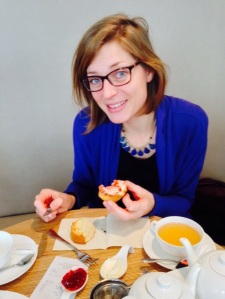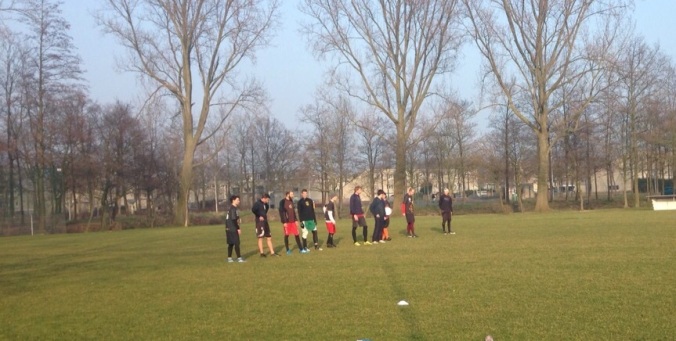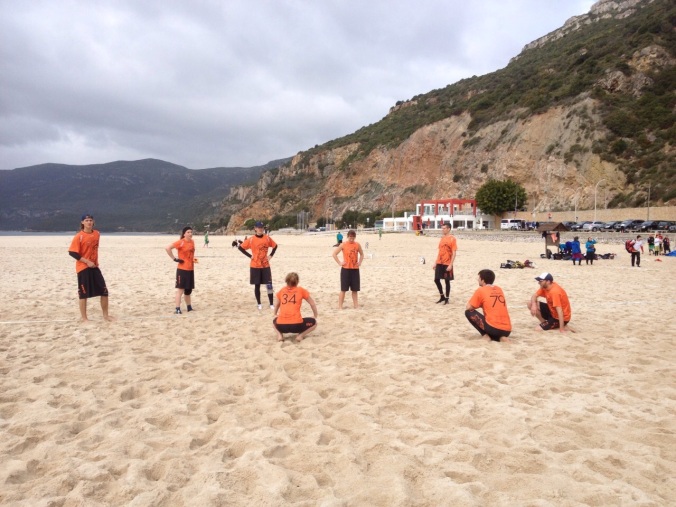Written by Inger Janssen (Dutch National Beach Mixed team; NBFT)

Inger – NBFT player & nutritionist.
Every now and then, when teammates hear that I am graduated as a nutritionist, I get asked for advice: “What should I eat?”
Truth is, I am not a dietician, I am a researcher who knows how to set up a proper intervention study to look in populations, individuals and at cell level, at effects of diet, supplements or certain foods.
So this question is kind of hard to answer as the answer depends a lot on the person asking. Let’s look at ultimate players in general. This means that the person in question has at least some level of physical activity, but several questions still remain:
- Is it a man or a woman?
- Is he or she currently in training as preparation for an important tournament?
- What kind of practices is he or she having?
- Strength training or durability?
- Is he or she recovering from an injury?
These are just some examples of elements that determine what a person should ideally eat. But I will try to give some general guidelines here, including more specific information on topics that my teammates requested.
Sorry about this opening statement…
As a nutritionist, one of the most frustrating things I come across is an extreme focus on detail when talking about food. Nutrition science has gone into researching the effects of tiny, tiny parts of your food in relation to massive health outcomes. There are so many steps in between the micronutrient intake of an individual and the effects of that intake on say, physical performance of that person, I cannot even start to describe how many factors are influencing this claim or research. (Micro)nutrients are part of a food product, together with other nutrients. The combination of different nutrients determine for instance their absorption rates in the body. Next, that food product is part of a meal, together with other food products. This meal is part of a number of meals per day, which is part of a dietary habit. Which interacts with lifestyle, physical activity and genetics or how your body works. In short: it is irrelevant to look at one ‘miracle’ nutrient or food product which will make you a healthy person or a better athlete. And, in my opinion, this also works the other way around. There is no such thing as one part of your food that you should completely avoid, like the no carb diets (even fat should be part of a healthy diet!). Except perhaps for burned food. Just don’t eat that.

Why then, is talking about food, and thinking about nutrition important?
When you take your sport serious, when you are trying to ‘lift the ceiling’ of your own and your team’s performance, you should see nutrition as an element that can help making the difference in lifting the ceiling a little higher. Because, in spite of what I mentioned above, you CAN do things really wrong or right with the food you eat.
So, keeping this in mind, what then should I eat?
Assuming you are an athlete, then thinking about food is not about losing weight and counting calories. It is about putting things in your body that your body can use when recovering from exercise, or to build up muscle. Energy balance is of course important, but when you are eating only empty calories, this is not going to help your body at all. For ultimate players this means that you should think about giving your muscles the right nutrients at the right time in order to replenish your supply of energy that is stored there, and to give your muscles the right building blocks when you are working on getting stronger. And your food should give you the right amount of energy to be able to deal with the physical challenges that ultimate is asking from your body, preferably from sources that besides energy give you other great things such as minerals, vitamins and essential amino acids.
“think about giving your muscles the right nutrients at the right time”
Supplements
In general, a varied western diet, like ours, does not leave us malnourished. Eating supplements is therefore not really necessary. You can even risk ingesting unhealthy levels of certain vitamins and minerals as some supplements consist of ridiculous amounts of those elements. I’m throwing in one of my favourite quotes by the scientist Paracelsus: “Alle dingen sind gift, allein die dosis macht das ein ding kein gift ist.” – Everything is poison, only the dose determines when a thing is not poison.
In addition, if you choose to eat supplements, be aware that some of these can contain ingredients that are considered to be doping.
See http://www.dopingautoriteit.nl/programmas/dopingwaaier-nl for more information on this. They have also developed a useful app in order for you to know whether something is or isn’t allowed.
Vitamin D
Probably the only thing that ultimate players should keep in mind is the lack of vitamin D during the dark winters. Vitamin D affects muscle performance, and is being produced by your own body under the influence of sunlight. Which is something that only comes in limited supplies during Northern European winters. I didn’t do research yet on whether there is actually a vitamin D3 supplement that is taken up by the body properly. The best alternative for now is to get as much daylight as possible, or to play beach ultimate tournaments in sunny countries regularly during winter, Of course.
Iron and vegetarians
On request of vegetarian team mates, here is some information on iron. This information comes from the book ‘Thrive’ by Brendan Brazier – which is a guide for sports nutrition for vegans. Keep in mind that the mentioned sources do not include animal products, but certainly meat is a source of iron as well.
“The main role of iron is to fabricate haemoglobin to facilitate red blood cell health. An adequate iron level is of paramount importance for the active person. A well-maintained iron level ensures the body is able to deliver oxygen-rich blood to the hard-working extremities, maximizing efficacy. Also used to build blood proteins needed for food metabolism, digestion, and circulation, dietary iron is essential for proper functionality. Iron absorption is improved when it is ingested at the same time as vitamin C-rich foods.”
“Best Thrive sources: spinach, legumes (especially split peas), pumpkin seeds. Combine with vitamin C rich foods such as oranges.”
Food should taste good!
Another one of my firm believes is that food should taste good. This is of course a highly biased statement. I happen to find healthy things tasty. But I also happen to find ‘unhealthy’ things tasty. For example real cheese. Preferably old cheese, which is really salty and fat. I would choose that any day over the low salt, low fat alternative. Because the alternative just doesn’t taste as good as the real thing. If you are not enjoying what you are eating; risk of diving into the candy jar is higher! A depressing breakfast of said cheese on toast, with a glass of no sugar, no fat dairy drink does not get my system running. I stay unsatisfied by my meal and will crave other non-healthy stuff to seek satisfaction. So while you may eat the right nutrients by design, your motivation to stay on the right path only takes you so far if you’re not enjoying it. So, it is fine to eat the unhealthy option, as long as you are really enjoying it. Give it your full attention while you are eating, the cheese makers deserve it. And you will feel more satisfied.
Whole foods vs. processed foods
Basically, a good general thought is to stick to foods that are as little processed as possible. You don’t have to shop at an overpriced wholefood store for this, also in your local supermarket you can choose the healthy option. The general rule of thumb (quoting Michael Pollan) “Don’t eat anything your great grandmother wouldn’t recognize as food” Quoting from his book ‘In defense of food’:
“There are many reasons to avoid eating such complicated food products beyond the various chemical additives and corn and soy derivates they contain. One of the problems with the products of food science is that, as Joan Gussow has pointed out, they lie to your body; their artificial colours and flavours and synthetic sweeteners and novel fats confound the senses we rely on to assess new foods and prepare our bodies to deal with them. Foods that lie leave us with little choice but to eat by the numbers, consulting labels rather than our senses.
It’s true that foods have long been processed in order to preserve them, as when we pickle or ferment or smoke, but industrial processing aims to do much more than extend shelf life. Today foods are processed in ways specifically designed to sell us more food by pushing our evolutionary buttons – our inborn preferences for sweetness and fat and salt. These qualities are difficult to find in nature but cheap and easy for the food scientist to deploy, with the result that processing induces us to consume much more of these ecological rarities than is good for us. “Tastes great, less filling” could be the motto for most processed foods, which are far more energy dense than most whole foods. They contain much less water, fiber, and micronutrients, and generally much more sugar and fat, making them at the same time, to coin a marketing slogan, “more fattening, less nutritious!”
Eating during a tournament
One of the best advices I’ve heard about nutrition for tournaments is: do not drastically change your dietary habits for that one week. Your body is used to a certain diet, if you go and change that drastically during a tournament, you will not feel well. Therefore, it is important to think about what you are eating when you are in training for a tournament.
Use preparation tournaments to see for yourself what works best. Start with trying out a different breakfast before games, or a different lunch. Test to see how your body reacts to eating nuts instead of chocolate between games. Or try a protein bar after practice, or after a day of games to see how your body feels.
Example: I know that some team members are thinking of cutting snacks from their diets in the weeks leading up to Dubai. This can be wise, but only when done rationally. You don’t want to go hungry in the weeks leading up to a tournament. And you don’t need to lose weight around that time – if you want to lose weight, do it earlier than one month before. It can however be a good idea to introduce ‘new’ snacks to your body, so you can see how your body responds to the thing you are planning on eating during worlds.

Breakfast for champions; Greek Yoghurt, muesli and some nuts and/or a piece of fruit
Breakfast
CLEARLY, you need to eat a proper breakfast during tournaments. With proper breakfast I mean a mix of easily digestible carbohydrates (fast sugars) and more complex and slower digestible energy sources. A bowl of (Greek) yoghurt, with muesli, some nuts and a piece of fruit would be a good option. For focus before a game, consider drinking coffee for the caffeine. I would recommend this, because coffee is delicious. Do take into account enough time for a toilet visit, because coffee can have a stimulating effect on bowel movement.
For your viewing pleasure:
Lunch
Your body needs time to digest meals, therefore, eating a large lunch between games is not recommendable at a tournament. To make sure you get the energy you need, it is more advisable to eat smaller portions with intervals. And to eat foods that are relatively easy to digest.
“during a tournament: eat smaller portions with intervals”
Dinner
Eat your main meal directly after the last game of the day. 1 hour after exercise is a critical period in which you want to give your body proper food in order to recover faster. When it takes longer before you can eat a proper meal, then it is advisable to eat a high-protein snack (or bar). Below you’ll find an example of how I organized my diet around Worlds in Lecco last year:
Inger’s shopping list for Worlds (Italy, 2014)
Breakfast
- Banana/other fruits
- Partly homemade muesli mix [including oatmeal, seeds, dried fruit, almonds, walnuts]
- Dairy [milk powder in case there is no yoghurt or fresh milk]
- Tea and coffee
Lunch
- Find alternatives for bread: pasta salad, rice salad with veggies, some protein
- Peanut butter / almond spread
- The Schlagwich J
Snacks
- Energy bars (Mule bar, etc.) – as little processed as possible – check if you recognise the ingredients. These kind of bars are really fashionable at the moment, look in your local wholefood shop what they have.
- Nuts and dried fruits mix [trail mix]. You can make small bags with portions per day.
- Dates, apricots, …
- Dried meat [small sausages]
- Nougat (this is really sugary, and not preferable – but I can’t eat much during tournaments and then this is my emergency food because it is tooooo delicious.)
- Ontbijtkoek
Drinks
- Just water. Might consider buying mineral water if you don’t trust tap water quality.
- Nuuntablets in different flavours for electrolytes [otherwise you don’t want to drink it anymore after a week] I always dilute way more than advised (add more water).
Directly after a day of games
- Recovery bar high in protein [Vega chocolate/coco] – can be ordered online.
- I do this because it is easy to eat directly after exercise when your body needs it most. And I find it hard to eat enough during the day, so this makes it easier. It is however not necessary to get your carbs and protein from a bar – natural products are fine as well – but for me harder to eat in tournament situations.
- DINNER: Italy, so pasta!
- Yoghurt before bedtime. [Again, because I find it hard to eat a lot at once – I spread my eating moments over the evening]
 Example of a good nutritious dinner. Mjummie!
Example of a good nutritious dinner. Mjummie!
 Salads for champions!
Salads for champions!
Drinking
Proper hydration has a direct effect on performance. Make sure you drink properly before, during and after exercise. This does not mean: the more, the better. It is actually the great marketing machines of sport drink companies that promoted an excess consumption of fluids during sports. Research has shown that people actually die more often because of drinking too much (during marathons), and many more people suffer from less severe complications because of over-drinking of water and sport drinks.
[http://www.health.harvard.edu/blog/trade-sports-drinks-for-water-201207305079]
You only need added salts in your water when the exercise is long, heavy and in hot sweaty weather. Our normal diet contains more salt than we really need already. Sugar can be useful during a game. Especially during competition days or tournaments, when you play more than one game per day, and you have problems with eating proper meals in between games.
Alcohol and sports
Could be a fun subject to look into, but I didn’t really do this up to now. Common sense and personal experience tells me it is good to not drink when you demand extreme things from your body. Alcohol does put a burden on your body, and with drinking alcoholic beverages, you take in a lot of empty calories and sugar which you don’t need.
Soft drinks
Are horrible. And most sport drinks fall into this category as well, unfortunately.
The importance of a healthy habit
Talking about food and eating in general, on non-competition days or tournaments, common sense helps a lot. What your mom (or grandma) told you is probably the way to go. I’m not going to give you the general guidelines to eating healthy. Only this:
“Eat your regular meals, take your time for it, preferably prepare them yourself, use fresh ingredients, vary (the more colour, the better), include ingredients from all main groups (carbs, veggies, proteins etc.). You can vary endlessly with product from those groups. It helps to have a well filled cupboard.”
Example:
Carbs/staples: pasta, rice, couscous, bulgur, potatoes,…
Veggies: in season is the way to go. Tomatoes, eggplant, cauliflower, zucchini, carrots, bell peppers, broccoli, beets, lettuce …
Protein sources: nuts, seeds, meat, fish, cheese, eggs, dairy,…
Taste (ànd sources of goooood stufffff): onion, garlic, ginger, red pepper,…
Fruits: experiment with adding apple, pomegranate, orange, pineapple,…. to your dinner.
“Mix this in any different combination, and you’re good. I like to add curry mix, or kecap, or soy sauce to give a different twist to my meals. But beware of huge amounts of salt that are usually in the standard mixes.”
Questions to consider
- What are your habits?
- How are you dealing with your pitfalls?
Disclaimer:
This article reflects the opinion of the author. It is based on great articles by nutritionists that have a passion for diving into the latest nutrition research, but she gave up on that a couple of years back, due to mentioned frustrations. It is meant to have the reader critically reflect upon their nutrition habits, mostly in relation to sports, but possibly in general.
If nutrition science since then came up with evidence that prove her she is wrong, she is interested to hear about this. But only if it is evidence coming from a double blind randomized controlled trial in a representative population. Thank you.
This article was peer reviewed by my nutritionist friends.
Further reading










 Example of a good nutritious dinner. Mjummie!
Example of a good nutritious dinner. Mjummie! Salads for champions!
Salads for champions!